THE MARV WOLFMAN INTERVIEWS wrap with a look at an industry-changing epic…
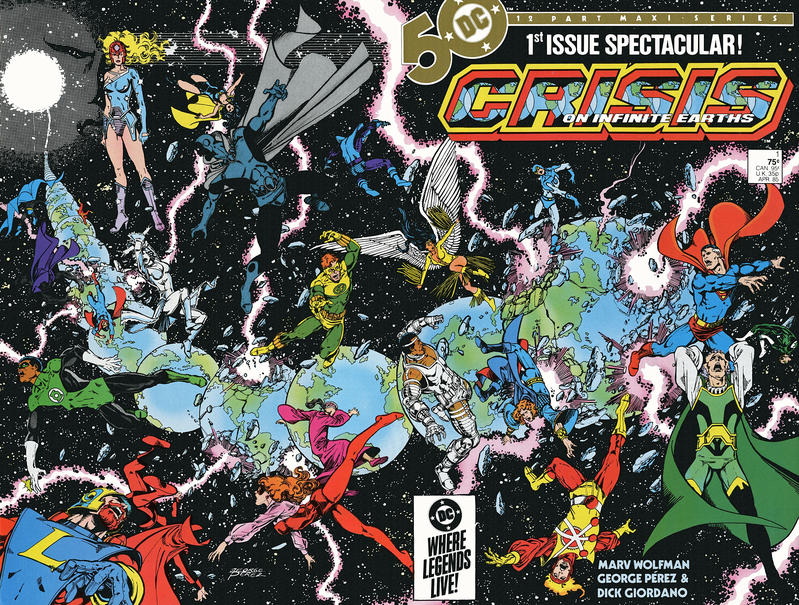
George Perez
—
In this final installment of THE MARV WOLFMAN INTERVIEWS, the Bronze Age great discusses Crisis on Infinite Earths, the origin of the Monitor, insight from Alan Moore — and how the story didn’t end quite the way he wanted.
For THE MARV WOLFMAN INTERVIEWS Index, click here.
—
Dan Greenfield: Now, right around the time New Teen Titans was an enormous hit, Crisis started to enter the picture. What was the genesis of Crisis on Infinite Earths?
Marv Wolfman: People ask that and it still stuns me because on the inside front cover of the first issue, and it’s been reprinted in every single reprint, I actually explained all that. I think people think I just made that up, I don’t know. But it’s totally true or I’ve been so consistent in my lying it’s beyond belief. (Laughter)
But, I was the writer of Green Lantern. I was writing the letter column and some fan—whose name I can’t think of at the moment but generally can—wrote a letter saying DC continuity makes no sense. And I wrote, as an answer to it, “Yeah, one of these days we should fix that.” Then I headed out…
We were going to a convention in either Philadelphia or Pittsburgh—I don’t remember which at this particular point—that afternoon and because I’m always early I got to the train station before everyone else did. Hours before! (Laughter) At least an hour before. And while sitting there waiting for everyone else to show up to take the train down to Pennsylvania, that letter, for some reason, kept haunting me and suddenly the whole storyline came together.
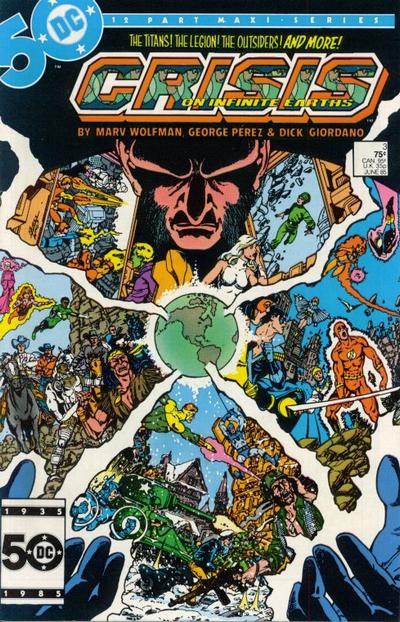
The Monitor muses. Art by Perez.
I had, as a kid—like 7 years old—a character that I made up called the Librarian, who had a satellite in space, who observed all the different superheroes and knew all their secrets, everything like that. We just changed his name, essentially, to the Monitor. I don’t know if Monitor is any more interesting a name than Librarian but “M” is a stronger letter sound than “L” so we went with that. And by the time everyone came, I pitched them the story and just asked them what they thought and everyone really talked about it the whole trip down there.
That Monday, I went into Dick Giordano’s office and pitched it to them. It was under the title, History of the DC Universe then. Dick loved it, brought us in to Jenette Kahn, who was the publisher, and she loved it. DC’s sales at that point, except for the Teen Titans and the Legion of Super-Heroes, were very bad. … Marvel’s sales were huge, as was Titans, but DC’s sales (overall) were very poor because DC sort of still thought they were dealing with a kid audience and most of the people now were at least in their teenage years or early 20s by that point.
So, this would be something that would change the DC Universe, that would make it more interesting to the Marvel fans to come over and I spent a couple years working up the plot in detail to make sure that everything made sense. This was gonna be so large and so difficult to do that you couldn’t just make it up as you went along. Everything had to make sense from Day One and there had to be a reason why everything was there.
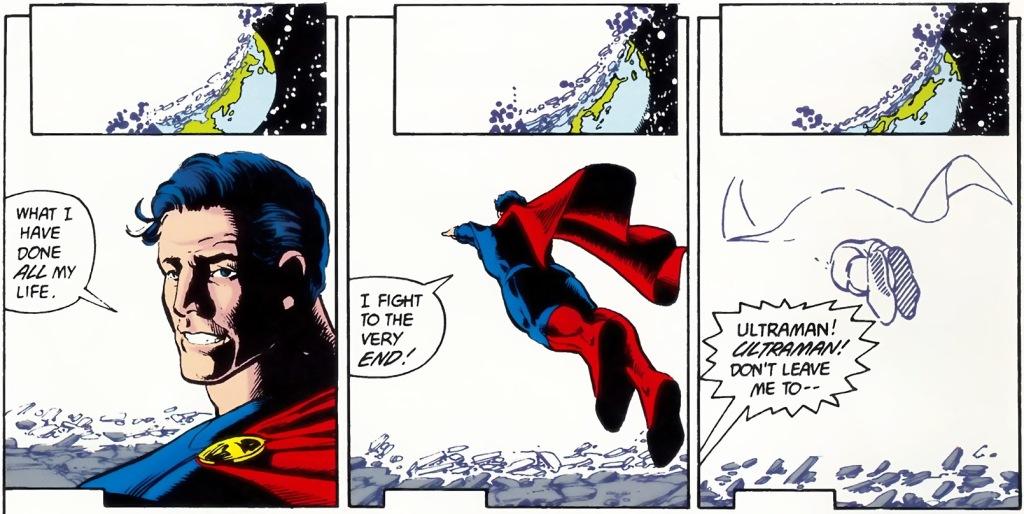
Crisis #1. Pencils by George Perez. Inks by Dick Giordano.
After the first issue came out, Alan Moore wrote a fan letter to me — personally so I didn’t publish it — but he’s the only person who ever got why the story begins with the death of the villain Earth DC had with Ultraman and Power Ring and a whole bunch of other characters. But they were the superheroes who were villains. But they were Superman; they were Batman; they were Green Lantern. They were just evil. Got rid of them in four pages and the reason was I had made a decision right from Day One that the real Superman, the real Batman, the real Wonder Woman—they would not appear in the book for five or six issues.
My feeling was that if the Marvel fans did not like DC, it’s probably because they tried Superman, Batman, and Wonder Woman at the time and didn’t like the characters and they didn’t know all these other characters that DC had. They just made a decision based on what everybody knew. Superman, Batman, Wonder Woman. So, they wouldn’t appear and I wanted to show how powerful the villain was because in four pages he got rid of Superman, Batman, and Wonder Woman instantly! Without even, really, a struggle! And that was purely psychological because I knew the fans would not piece that together but they’d suddenly realize, “This is a really powerful villain because he just destroyed Superman, Batman, and Wonder Woman!” even if that wasn’t quite their names.
So, a lot of little things like that but that took time to layer in. You couldn’t just rush that story out. It was announced, I think, in 1981. There’s ads for it under the title, History of the DC Universe, and we didn’t publish it ’til ’85. … Once I realized DC’s anniversary, 50th anniversary, was in 1985, we used that as a point to publish it because it was a great time to say, “50 years and now it starts all over.”
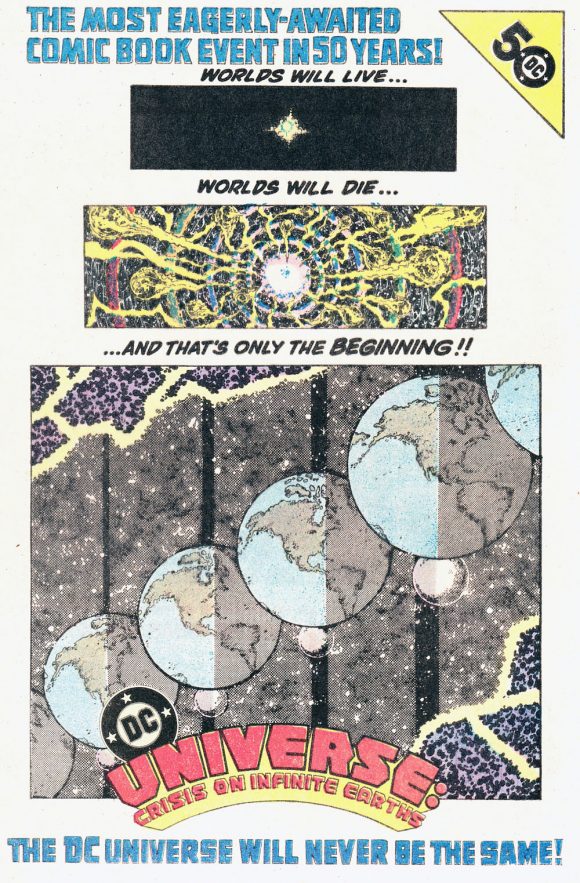
House ad
—
Dan: Did you have an expectation that some day DC might change the universe yet again? Because between now and then they have rebooted their universe back to a multiverse. … They’ve rebooted it repeatedly every seven, eight, 10 years in the 30 years or so since. What’s your take on that and what was your expectation at the time?
Marv: Well, I never thought Crisis would be remembered. I seriously didn’t. I thought Crisis was the road map to where we… (Pauses) Because part of the pitch on Crisis, it was from January 1985 to December 1985. That whole 50th anniversary year. And then in January of 1986, we were supposed to start every book new, with a new #1. I fought for that for so long! And Dick Giordano, who was the editor-in-chief at the time, in his autobiography said that the only mistake he made was not doing that and he said the only reason he didn’t do it was he didn’t think he had enough good talent to actually re-create every book from scratch.
My view was that I believe every generation deserves the characters to be redone for them to some degree. I’m a Baby Boomer. When Showcase #4 came out with the Flash, the first appearance of the Barry Allen Flash, I had no idea there ever was a previous Flash! I was born at a point that, by the time I could read a comic book, all those books were gone and people didn’t talk about it. There was no fandom. There was nothing, so I had no idea there was a previous… there was a Justice Society. I had no idea there was a different Flash. In that Showcase story, Barry is reading a copy of The Flash. Obviously, he was a big fan but I thought that was just a funny joke. No knowledge that these characters existed, so for me the new Flash, Green Lantern and Hawkman were the first time these characters appeared but they were written for my generation. They weren’t magic anymore. They were science-based and all of that sort of stuff.
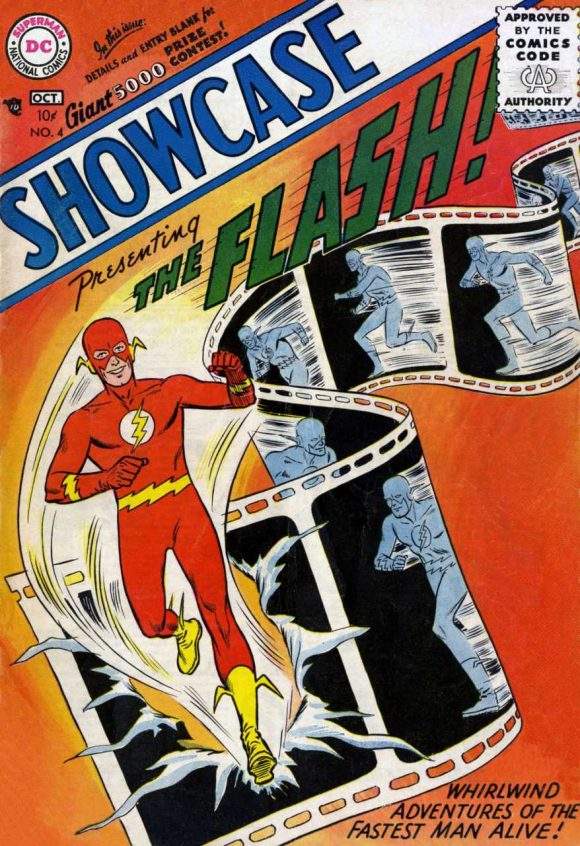
Carmine Infantino pencils, Joe Kubert inks. Design by Robert Kanigher.
I do believe that every generation should have it. Otherwise, Green Lantern would be powerless against somebody who had a pencil (Dan laughs) because he was powerless against wood, the original character. Or, as they said on The Big Bang Theory, “You mean I can defeat both the old Green Lantern and the new Green Lantern with a No. 2 pencil?” since it was yellow. (Laughter)
To me, those type of arbitrary gimmicks are ridiculous and each generation gets smarter because they get a little bit older and they want something a little bit better. So, I do believe that characters should be rebuilt and restructured, but not every couple of years. It took 50 years to do one and it should have been at least 25 years. Every 25 years from that point on. But I do agree with the concept, yes.
—
(An audience member asked Wolfman about his original ending for the story.)
Marv: Yeah, the ending… I was not allowed to do the ending that I had wanted. I was overruled on that. The editors overruled me and they were completely wrong.
Dan: What was the ending you wanted to do?
Marv: My goal, the original concept as I pitched it, was that the series would simply end with the rebirth of the earth and all the heroes would start the next month and not one of them would ever know that the Crisis had ever happened because the Earth had been reborn and now we’re 10 million years later or however old the Earth is. A hundred and fifty million years. And everyone was being born for the first time so if there was a new Flash, they’d be born with a whole new approach, a new concept, a whole new whatever.
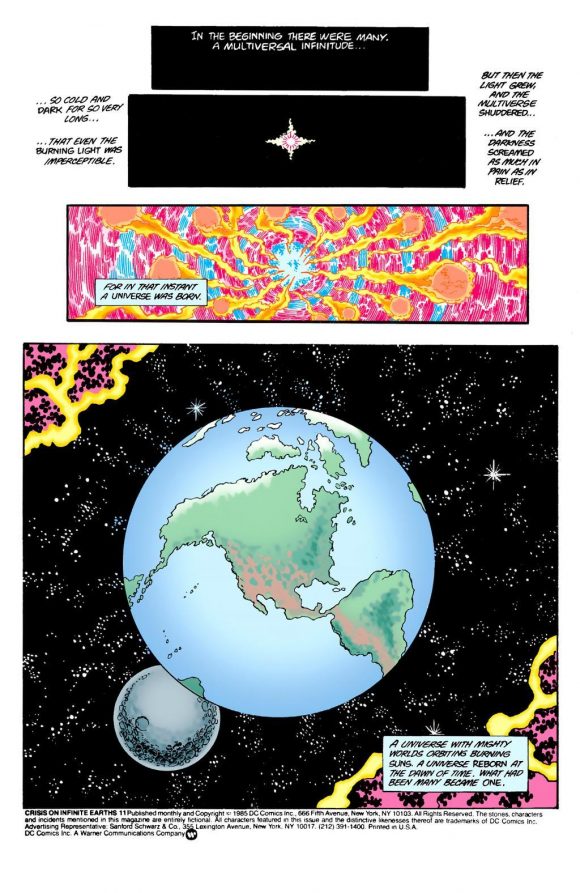
Crisis #11. Pencils by Perez. Inks by Jerry Ordway.
And I was told that the editors didn’t like that because if the heroes didn’t remember all their stories, it would invalidate everything that had existed previously, to which I answered with extreme sarcasm, “Our heroes do not buy our comic books. (Laughter) The fans do and they will still have all those books on their bookshelf and they will remember all those things.”
But all the editors overruled it so that’s why I had the heroes go back in time to before the world is reformed, so that they would be around to have remembered it. They didn’t cease to exist and get reborn. They were there the whole time. Then it was five years of everybody talking about, “What really happened in the Crisis?” which is, I knew, what would happen.
But I moved out of New York at that point so that was their problem. And (DC co-publisher) Dan DiDio has been trying to fix that ever since. So, he’s been really struggling! He agrees with me that that was the way it should have been, where everything starts new. You just get… You keep repeating the same things. Why start over if all you’re gonna do is remember about how bad things were, how awful things were? You need to start clean and create for the new generation a brand-new version, without having them already know the last 30 years of continuity. I hate continuity. You have to understand that Crisis existed to wipe out all continuity and start new.
—
MORE
— The MARV WOLFMAN INTERVIEWS Index. Click here.
— 13 QUICK THOUGHTS: A Look Back at DC’s CRISIS — and What it Wrought. Click here.

September 12, 2018
This was an incredibly fantastic interview.
September 12, 2018
Why, thanks!
September 12, 2018
I felt that the Crisis was a mistake. I thought keeping the Earths separate was better because at least you didn’t have at least two versions of each character co-existing on the same Earth. It made it more crowded and screwed up continuity worse (Hawkman’s history is a good example).
And then DC had to keep rebooting (Zero Hour 1994 to start) every so often. I got confused and by the early 2000s really lost interest. Got tired of the constant new #1 issues. Great for new fans, certainly, which was the point. But I was often scratching my head. Batman was my favorite title until the 1990s when it got a bit too nihilistic and grim and I hated the Kelley artwork.
But I kept collecting until 2011 when they rebooted AGAIN (I understand commercially why) and started every title at #1. That’s where I stopped collecting for the most part. Only Batman ’66 and a handfull of others were on my list. And I have every issue of Batman and Detective from 1961 to 2011 (and a fair number of 1940s and 1950s issues as well). Every issue of the original Justice League run (hey I started collecting in 1965 at age 7).
So while I thought Crisis was well conceived and executed, its fallout is what eventually turned me off from collecting. Sure good stories are good stories but much of what I see now is beautiful art and not so good storytelling. I do enjoy Neal Adams’ occasional forays into the world of comics though. I loved his work.
Well this is an old curmudgeon ranting. 🙂
October 16, 2025
And this old curmudgeon completely agrees with you! Beautiful George Perez artwork on just about every DC hero, but Crisis failed in its purported mission to “simplify” a DC Universe that didn’t need simplifying. It only made things more confusing, as neither fans nor even the creators know what “really happened” and what didn’t or what the status quo is for various characters. Now they reboot the DC Universe every couple of years, which only adds to the chaos.
October 16, 2025
Bob Haney had the right idea…..just tell good, fun stories. If you are a good writer with a story centered around WWII JSA characters then tell it. If it sells then it did what it was intended to do. Entertain the fans and make coin for the publishers. But to put your writers all in a box does nothing but restrict both the creators and the fans. We all lose.
September 12, 2018
Great interview but I’m disappointed to hear that Marv hates continuity.
Continuity keeps the comics world feeling “realistic”.
I don’t get to start fresh every 25 years and forget what happened before, why should Superman?
August 21, 2020
Because Superman isn’t real.